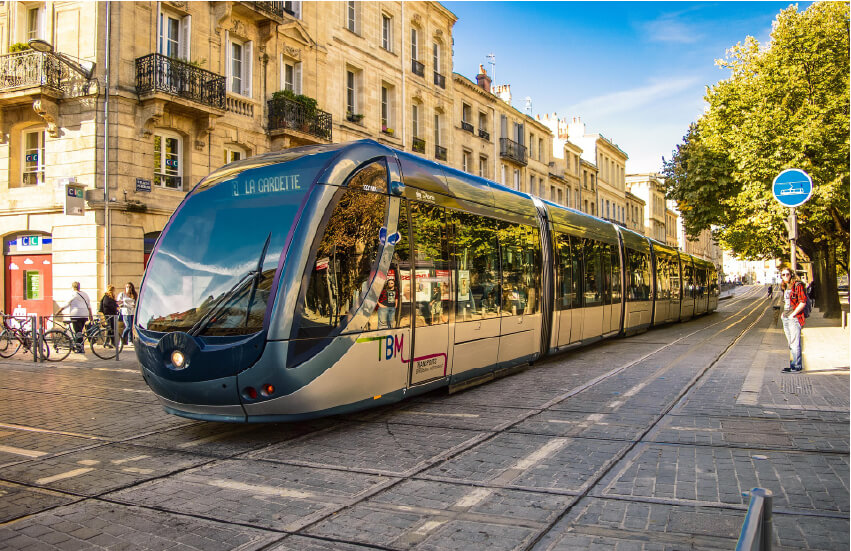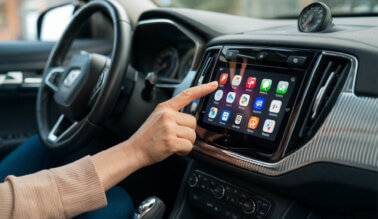A practical look at use cases and network readiness
by Baruch Pinto | July 24, 2025
Not all technological developments are created equal. Some can be implemented right away, while others need a long period of preparation, from building out infrastructure to growing the supporting ecosystem. So whenever we hear about breakthrough technologies, a question comes up: How close are we to actually benefit from them?
This question is especially relevant in the context of C-V2X (Cellular Vehicle-to-Everything), a technology that promises to reshape transportation as we know it. Along with autonomous driving, many other applications are quickly emerging, including real-time hazard alerts and truck platooning, but not all of them are plug-and-play innovations. When cellular networks are involved, enabling these use cases often means upgrading to 5G SA for ultra-low latency or deploying roadside units. These deployments require more than just innovation, they demand readiness.
So are we ready for C‑V2X at scale? Is the infrastructure in place, the ecosystem aligned, and the technology stack mature enough to support these use cases in real-world deployments?

Are cellular networks ready for C-V2X?
Before assessing how “ready” cellular networks are for C‑V2X deployments, it’s essential to clarify a possible misconception. When people hear about C‑V2X (Cellular Vehicle-to-Everything), they might assume it refers to a single technology stack where all use cases, from emergency braking to navigation updates, run over cellular networks. In reality, the technology is split into two distinct communication modes, and understanding this distinction is crucial.
The first mode is called PC5 and enables direct communication between vehicles and roadside infrastructure without relying on the cellular network at all. PC5 doesn’t need a SIM card or even a cellular base station. Instead, PC5 uses a dedicated radio interface built into C‑V2X chipsets, which constantly listens and talks to other devices in the 5.9 GHz spectrum. Short messages, like “I’m braking now” or “Emergency vehicle nearby,” can be shared up to several hundred meters away in a few milliseconds. This is vital for mission-critical safety tasks like avoiding crashes or handling emergency braking.
The second mode is called Uu communication, and it does rely on the cellular network. This is where the readiness of LTE or 5G networks becomes relevant. Uu enables long-range and cloud-connected services such as real-time navigation updates, OTA software updates, fleet diagnostics, and advanced coordination. These services need stable coverage, sufficient bandwidth, and, for some applications, low-latency performance.
Let’s take a look at the various Uu use cases, see what their requirements in terms of connectivity are, and assess whether they can be implemented right now.

Traffic and Navigation Updates
Updates are delivered in real time through the cloud, providing vehicles with routing information and hazard alerts. This use case requires moderate bandwidth for map data, reliable coverage, low latency, and resilient handover between towers in mobile environments.
In terms of readiness, 4G LTE infrastructure is sufficient in most urban and highway settings. However, some coverage gaps may remain in rural and cross-border areas. While 5G enhances real-time richness, such as enabling HD maps, it is not essential for basic navigation.
In fact, deployments have already started. A particular variation of this use case, Vulnerable Road User (VRU) alerting, has been deployed in real life in February 2025 in Fort Bend County in Texas. It is one of the first U.S. deployments of C-V2X technology aimed at improving safety around school zones, and it plans to equip around 120 schools with C-V2X-enabled beacons and crosswalk notifications, helping alert drivers via displays and a smartphone app when students are present.

Transit Signal Priority
Transit signal priority allows buses and trams to request green lights by communicating with infrastructure via a cellular network. This use case depends on low latency (ideally under 100 milliseconds) to align with traffic light cycles. It also requires high reliability and uptime, prioritized data delivery and integration between roadside units and traffic management centers.
LTE networks can support this use case but require strong radio access network planning. 5G with ultra-reliable low-latency communication (URLLC) can improve consistency, especially at scale.
There are real-world examples of this use case, too. Utah Transit Authority launched the Bus Transit Signal Priority Project, aiming to cut travel times, increase reliability, safety and route efficiency, and reduce emissions. While earlier deployments used Dedicated Short-range Radio Communication (DSRC) technology, from 2023 on, deployments use C-V2X technology, and the Utah Department of Transportation is replacing DSRC to conform to the new standard.
Emergency Vehicle Preemption
This use case might seem similar to the previous one, but it has different performance requirements. Technically, it gives immediate unconditional priority at intersections to emergency vehicles like fire trucks, ambulances, and police during response missions. It requires ultra-low latency and high reliability, priority handling over other types of data traffic, as well as seamless communication during high-speed vehicle movement.
While technically LTE can support this functionality, it may be strained in congested areas unless prioritization mechanisms are applied. 5G with network slicing and URLLC provides a much more robust solution.
Over-the-Air (OTA) Updates
These updates are used to deliver firmware, map data, and software patches directly to connected vehicles through cellular networks.
OTA updates require medium-to-high bandwidth, particularly for transmitting map or firmware files.
This use case is fully supported on both LTE and 5G networks, and many OEMs already use LTE or even 3G as a fallback to deliver OTA updates at scale. 5G can definitely improve speed and distribution efficiency, but LTE networks are already mature and, what is more important, widely deployed for this purpose.

Fleet Management and Diagnostics
Fleet management and diagnostics are supported through the transmission of vehicle health data and telemetry to centralized management systems. Uu supports both periodic uploads (such as health reports) and urgent alerts (e.g., system failures)
This use case requires continuous wide-area coverage, moderate uplink and downlink bandwidth, and integration with cloud-based fleet management platforms. LTE handles this use case well, while 5G can add further value by enabling low-latency diagnostics and real-time vehicle state streaming. Many commercial fleets already rely on public cellular networks for diagnostics and predictive maintenance, using eSIMs or private APNs.
Cooperative Perception Via Cloud
Cooperative perception is a C‑V2X use case where vehicles, infrastructure, and other road users share sensor data with each other in real time, through the cloud or edge computing platforms. The idea is to help vehicles “see” beyond their line of sight, for example, around corners or through obstructions. A good example is a truck that detects black ice on the road and shares that data with vehicles behind.
This is an advanced use case that requires ultra-low latency and high reliability. LTE technology is limited in its ability to support it, so 5G is essential to fully support real-time cooperative perception. This is one of the few use cases that truly requires 5G Standalone (SA) architecture to scale effectively. Therefore, it may be a while until we see mass deployments of cooperative perception on our roads.
Infotainment Services
Infotainment services, such as streaming media, emergency calls (eCall), and other in-vehicle features, are enabled through the cellular network. These services need enough bandwidth for streaming, voice, and navigation. They also require seamless mobility across cells and always-on connectivity through SIM or eSIM.
Although LTE is more than sufficient to support most in-vehicle concierge and infotainment services, 5G can enhance user experience by improving download speeds and responsiveness. Infotainment systems using public LTE are already widely deployed across various automakers, as well as cellular-enabled eCall.

What else affects C-V2X adoption?
In addition to infrastructure improvements, there are other technological advancements that are bringing C‑V2X use cases closer to large-scale realization. One of them is the completion of the new IoT Remote SIM Provisioning standard, SGP.32. This new standard is going to simplify IoT connectivity, reduce the time to market for IoT deployments, boost eSIM adoption and growth of connected device use.
This development is important for C-V2X use cases because many of them depend on reliable and flexible cellular connectivity, and SGP.32 enables vehicles to seamlessly manage their mobile network subscriptions without physical SIM swaps.
For example, traffic and navigation updates benefit from uninterrupted service, and SGP.32 can ensure a valid operator profile is available even during cross-border travel or network handovers. Transit signal priority systems can maintain service in areas with weak coverage by switching to a more stable operator, and in emergency vehicle preemption, SGP.32 provides resilience by enabling fallback to alternative networks if one of them becomes unavailable.
Fleet management and diagnostics are also streamlined, as SGP.32 supports fleet-wide provisioning strategies and allows vehicles to be connected to different mobile networks based on region or cost. Infotainment services also become more flexible and globally accessible, because now connectivity can be activated even after a vehicle is sold or enters a new market.
Overall, today’s cellular infrastructure and technology stack are largely ready to support many Uu-based C‑V2X use cases, such as fleet management, OTA updates, and infotainment services. Some of them, as we see, are already operational in commercial deployments. That said, some use cases may work reliably in areas with strong coverage, but in rural and remote locations they may be challenging because of coverage gaps or inconsistent handovers.
There are also demanding applications like emergency vehicle pre-emption, which require ultra-low latency and high reliability, and may be difficult to implement at scale without advanced 5G Standalone networks or features like network slicing. So, while significant progress has been made, mass adoption of Uu C-V2X use cases now depends on continued 5G infrastructure rollout, and the adoption of enablers like SGP.32 for seamless connectivity.

Webbing’s Solution for C-V2X Applications
Webbing offers a connectivity solution that ensures global access to reliable and high-quality internet, with low latency and the best of class coverage. It provides secure and continuous internet connection, delivering a streamlined, centralized, and scalable means of deploying, controlling and monitoring connected car fleets and infrastructure units for C-V2X applications.
As a global MVNO, Webbing’s network of 600+ mobile operators guarantee world-wide coverage. It allows to roam on several carriers’ network in every region, solving the problem of weak spots that any mobile network may have and ensuring full coverage and continuous connectivity even at remote locations.
Webbing’s distributed core network with local breakouts, multiple network solution, and data server redundancy can provide OEMs connectivity stability and low latency. It also allows for all types of localization – from IP traffic that remains in the country to designated profiles for emergency calls, so it’s easy to comply with local and regional connectivity regulation requirements even in the most regulated markets, such as Turkey.
Our eSIM solution ensures failover connectivity with the capability of using multiple mobile carrier profiles, easily changing carriers at any time with zero integration, and an option to fall back from a failing profile to a different profile without any need to communicate with a remote server. Webbing’s eSIM is aligned with the GSMA SGP.32 IoT eSIM specification, which means it will be fully compatible with the new standard when it becomes ubiquitous.
Webbing also offers a centralized way to manage eSIMs throughout their lifecycle, making deployments future-proof and eliminating the problem of ever-changing legislation on connectivity and data protection. With our solutions, OEMs can set up business rules that would allow connected cars to change the serving carrier automatically under specific conditions, such as location, loss of connectivity or even after a certain amount of time, which can be of use for cars shipped to some markets.
Our solutions help car manufacturers and transportation agencies overcome their connectivity problems and reduce time to market for global deployments, providing the benefits of roaming with multiple carrier options in every country, and seamless transition between carriers, while maintaining low rates and low latency on a global scale.
Reach out to learn more about our connectivity solutions that enable C-V2X applications.




